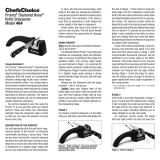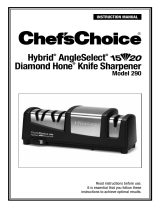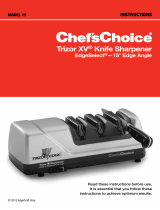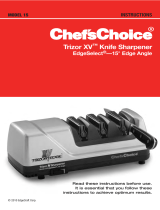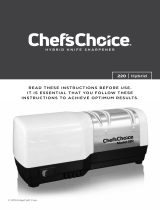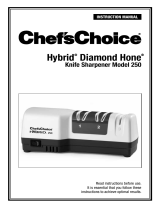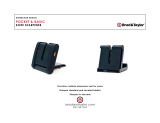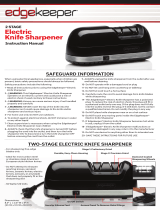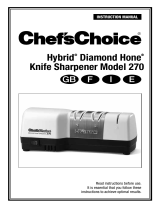
Diamond Hone
®
MultiEdge
™
Knife Sharpener
2 Stage
460
INSTRUCTIONS
For Use on Both Straight Edge
and Serrated Knives
The professional Chef’sChoice
®
Diamond Hone
®
MultiEdge
™
Sharpener Model 460, features
customized mixtures of 100%
diamond abrasives specially
designed to sharpen both straight-
edge and serrated knives. This
multipurpose manual sharpener
meets the needs of professionals,
chefs and serious cooks alike.
The Chef’sChoice Model 460 is a
2 Stage sharpener, incorporating
a pair of contoured roller guides to
ensure precise and consistent angle
control - stroke after stroke -as the
knife is presented to the diamond
sharpening elements. Both sides of
the edge are simultaneously shaped
and sharpened. This construction
ensures that the edges are well
formed and very sharp every time.
The abrasives consist of selected
100% single-diamond crystals
embedded on unique interdigitating
steel support plates. The Model
460 consistently outperforms
conventional sharpeners that use
less efficient abrasives and lack any
control of the sharpening angle.
Diamonds, the hardest known
material, are extremely durable.
Straight-edge knives sharpened
on the Model 460 will be “shaving
sharp” with a “bite” that helps them
cut effortlessly through tomatoes,
other vegetables and fruits. It makes
cutting and slicing a pleasure and
removes the drudgery of working
with dull knives. Straight-edge knives
are sharpened first with diamonds in
Stage 1 and then at a different angle
with still finer diamond mixtures
in Stage 2. This creates a double-
beveled longer-lasting arch-shaped
edge that is much stronger than
conventional “v-shaped” or hollow
ground edges. This unique arch
structure ensures a sharper edge
that will stay sharp longer.
Serrated knives sharpen quickly in
Model 460 using only the second
sharpening stage. The special
diamonds in that stage create
razor-sharp “micro-blades” along the
dominant teeth, enhancing the cutting
action and reducing the sawing and
tearing action otherwise typical of
serrated blades. Even new “factory-
fresh” serrated knives frequently have
poorly formed, dull saw teeth that can
benefit from sharpening and shaping
in the Model 460. Serrated knives
become dull because their teeth bend
and distort during use. The Model
460 restores dull teeth to better-than-
new condition. The cutting effective-
ness of the serrations depends
almost entirely on the sharpness of
the points (edges) of the teeth. It is not
necessary to sharpen the sides and
bottoms of the scallops between the
teeth, since in general, they are not
doing the cutting. The Chef’sChoice
®
Model 460 sharpener is designed to
sharpen teeth at the edge or point
so that the prominent teeth become
razor-sharp “micro-blades.”
Serrated knives sharpened with
the Chef’sChoice
®
Model 460 glide
smoothly through food and cut
cleanly with less effort. There is less
tearing or mutilating of all types of
food including meat, poultry,
vegetables and bread. The face of a
cut vegetable or fruit is smoother and
more appetizing. The sharpened
serrated knife is easier to control
allowing you to make thinner slices
and to manipulate the blade easily
for garnishing.
The “micro-blades” created by the
Model 460 along the prominent teeth
of serrated knives are unique in that
they give the knife some of the
qualities of a straight-edge blade
while retaining the sawing action of a
serrated edge. This combination
creates the ultimate serrated edge.
Before you begin...
The Chef’sChoice
®
Diamond Hone
®
MultiEdge
™
sharpener Model 460
is “ambidextrous”-extremely easy
to use whether you are right-or left-
handed. Stages 1 and 2 are marked
on both sides of the sharpener for
your convenience.
Place the sharpener on a level surface
about waist high. If right-handed,
arrange the sharpener with the
Chef’sChoice
®
brand name facing you.
Hold the handle with your left hand
making certain that your left index finger
and thumb remain safely behind the
partitioning wall where the handle
attaches to the sharpening stages.
(If left-handed, see Suggestions.)
Caution: Keep all fingers clear of the
blade at all times.
General sharpening instructions
Make certain the blade is clean - free
of all food, fat and grease - then
proceed as follows:
Holding the knife in the right hand,
place the blade into the “v-shaped”
slot and lean the blade securely
against the conical roller guides.
While continuing to keep the blade
in contact with the rollers, move the
blade smoothly back and forth in the
slot along the entire blade length.
Make sure one or both rollers move
with each back-and-forth stroke to
ensure that the blade is in good
contact with the rollers. It is not
necessary to lift the blade after each
stroke. Apply little or no downward
pressure on the blade. The light
sound you hear as the blade moves
across the 100% diamond abrasives
tells you the diamonds are doing the
work for you! Continue this back-and-
forth motion until the blade is sharp.
The Chef’sChoice
®
Diamond Hone
®
manual sharpener has been designed
with the optimal diamond abrasive
mixture to sharpen your knives
safely while producing an extremely
sharp edge. Coarser grits would
cause excessive wear and tear of the
serrations. The fine diamond grits
used in the Model 460 help extend
the life of your knives. The first time
you sharpen a knife may take a little
longer, but resharpening will be fast
and safe.

Instructions for use
Straight-edge Blades
(Use Stage 1 and then Stage 2)
Generally 25 back-and-forth strokes
in Stage 1 are sufficient to develop
a sharp edge. Hold the face of the
blade firmly against the contoured
rollers. One or both rollers will turn
as the knife is pulled or pushed back
and forth through the slots indicat-
ing proper sharpening and good
angle control. Maintain contact with
the abrasive but put no additional
downward pressure on the knife
while sharpening.
If the knife is very dull it may take
more back-and-forth strokes, per-
haps up to 50 or so through Stage
1 to develop a sharp edge. Do not
proceed to Stage 2 until the edge is
very sharp. It should, for example, be
sharp enough to cut easily through
the skin of a tomato.
Now, make 10 back-and-forth
strokes in Stage 2 to hone the edge
to shaving sharpness. Apply no
downward pressure on the blade.
Too much pressure can reduce
the ultimate edge sharpness. Test
sharpness by cutting a tomato, or by
cutting paper*.
* To test periodically for sharpness, hold a sheet
of paper by its edge and carefully slice through it,
making sure you cut a short but safe distance
from your fingers. A sharp blade will cut smoothly
without tearing the paper.
Serrated Knives
Serrated blades should be sharpened
in Stage 2. Generally, 25 back-
and-forth strokes in Stage 2 will be
sufficient. Keep the blade in contact
with the roller guides but apply no
added downward pressure on the
blade. Check sharpness by cutting
a tomato, vegetable or fruit. Note the
improved smoothness of the cut after
the blade has been sharpened. (The
paper cutting test is inappropriate for
a serrated knife.)
If the blade needs further sharpening,
continue back-and-forth strokes in
Stage 2 until the desired sharpness
achieved. Sharpening in Stage 1 can
remove excess metal and shorten
the life of the serrated blade,
consequently use that stage only if
the teeth are extremely dull or bent.
Resharpening
Knives can be resharpened using
the procedures described above.
However, resharpening will be much
faster and, in general, require only
about 25 full back-and-forth strokes.
You will be able to resharpen your
serrated knives many times before
the serrations become notice-
ably worn. Although the diamond
abrasives used in the Chef’sChoice
®
Diamond Hone
®
Manual 460 are very
fine, in time, serrations will be reduced
in size. However, a serrated knife that
may have become useless because
it was too dull will be revitalized by
the Chef’sChoice
®
Diamond Hone
®
Manual sharpener
Suggestions
• If left-handed, turn the sharpener
around, hold the handle with your
right hand and the knife with your
left, and follow sharpening and
honing instructions above.
• With thick straight edge blades,
it is sometimes useful after
following the instructions for Stage
2, to turn the sharpener around,
holding the handle with the other
hand, and carefully repeat the
sharpening process in Stage 2 with
a few back-and-forth strokes from
the other side. Be sure to maintain
blade contact with the rollers.
• Straight edge knives that are
extremely dull may require many
strokes in Stage 1. Stop periodically
and check the blade for sharpness
by carefully cutting paper.
Then hone the knife in Stage 2.
Electric Knives
It is possible to sharpen the serrated
blades of electric knives that have
become dull. First disassemble the
two blades used in most electric
knives and sharpen individually as
described above.
Maintenance
• The exterior can be cleaned with
a damp, soft cloth.
• No oils, water or other lubricat-
ing liquids are necessary with this
sharpener.
• Not for scissors.
EdgeCraft also offers a wide
range of popularly priced electric
Chef’sChoice
®
Professional
Sharpeners for those who have
many knives or a wide variety of
knives, and for those who wish to
sharpen faster and with less effort to
obtain the ultimate in edge sharpness
and durability.
A selection of Chef’sChoice
®
Professional Sharpeners is available
to safely sharpen either straight edge
or serrated blades. The presharpening,
sharpening and honing angles of all
Chef’sChoice
®
manual and electric
knife sharpeners are completely
compatible.
Limited Warranty:
Used with normal care, this EdgeCraft
product, designed for hand use only, is
guaranteed against defective material and
workmanship for a period of 1 year from
the date of purchase (“Warranty Period”).
We will repair or replace, at our option, any
product or part that is defective in material or
workmanship without charge if the product
is returned to us postage prepaid, with dated
proof of purchase, within the Warranty
Period. This Limited Warranty does not cover
replacement or abrasive pads necessitated
by use of the product or product damage
resulting from misuse. ALL IMPLIED
WARRANTIES, INCLUDING IMPLIED
WARRANTIES OF MERCHANTABILITY AND
FITNESS FOR A PARTICULAR PURPOSE,
ARE LIMITED TO THE WARRANTY PERIOD.
EDGECRAFT CORPORATION SHALL NOT
BE LIABLE FOR ANY INCIDENTAL OR
CONSEQUENTIAL DAMAGES.
Some States do not allow limitations on
how long an implied warranty lasts and
some States do not allow the exclusion or
limitation of incidental or consequential
damages, so the above limitations or
exclusions may not apply to you. This
Limited Warranty gives you specific legal
rights, and you may also have other rights
which vary from state to state.
This warranty applies only to normal
household use of this sharpener and is void
for industrial or commercial use.
MADE IN THE USA!
by the makers of the acclaimed
Chef’sChoice
®
Diamond Hone
®
Knife Sharpeners, sold worldwide.
EdgeCraft Corporation
825 Southwood Road
Avondale, PA 19311 USA
(800)342-3255 (610)268-0500
www.chefschoice.com
Chef’sChoice
®
EdgeCrafter
®
, EdgeCraft
®
and
Diamond Hone
®
are trademarks of the EdgeCraft
Corporation. U.S. Patents 5390431, 5582535, D368217,
D357395, other U.S. and foreign patents pending.
© EdgeCraft Corporation 2007 M461900
/
